Updated on October 11th, 2024 by Bob Ciura
Business Development Companies, otherwise known as BDCs, are highly popular among income investors. BDCs widely have high dividend yields of 5% or higher.
This makes BDCs very appealing for income investors such as retirees. With this in mind, we’ve created a list of BDCs.
You can download your free copy of our BDC list, along with relevant financial metrics such as P/E ratios and dividend payout ratios, by clicking on the link below:


Of course, before investing in BDCs, investors should understand the unique characteristics of the sector.
This article will provide an overview of BDCs. It will also list our top 5 BDCs right now as ranked by expected total returns in the Sure Analysis Research Database.
Table Of Contents
The table of contents below provides for easy navigation of the article:
Overview of BDCs
Business Development Companies are closed-end investment firms. Their business model involves making debt and/or equity investments in other companies, typically small or mid-size businesses.
These target companies may not have access to traditional means of raising capital, which makes them suitable partners for a BDC. BDCs invest in a variety of companies, including turnarounds, developing, or distressed companies.
BDCs are registered under the Investment Company Act of 1940. As they are publicly-traded, BDCs must also be registered with the Securities and Exchange Commission.
To qualify as a BDC, the firm must invest at least 70% of its assets in private or publicly-held companies with market capitalizations of $250 million or below.
BDCs make money by investing with the goal of generating income, as well as capital gains on their investments if and when they are sold.
In this way, BDCs operate similar business models as a private equity firm or venture capital firm.
The major difference is that private equity and venture capital investment is typically restricted to accredited investors, while anyone can invest in publicly-traded BDCs.
Why Invest In BDCs?
The obvious appeal for BDCs is their high dividend yields. It is not uncommon to find BDCs with dividend yields above 5%. In some cases, certain BDCs provide 10%+ yields.
Of course, investors should conduct a thorough amount of due diligence, to make sure the underlying fundamentals support the dividend.
As always, investors should avoid dividend cuts whenever possible. Any stock that has an abnormally high yield is a potential danger.
Indeed, there are multiple risk factors that investors should know before they invest in BDCs. First and foremost, BDCs are often heavily indebted. This is commonplace across BDCs, as their business model involves borrowing to make investments in other companies. The end result is that BDCs are often significantly leveraged companies.
When the economy is strong and markets are rising, leverage can help amplify positive returns.
However, the flip side is that leverage can accelerate losses as well, which can happen in bear markets or recessions.
Another risk to be aware of is interest rates. Since the BDC business model heavily utilizes debt, investors should understand the interest rate environment before investing.
For example, rising interest rates can negatively affect BDCs if it causes a spike in borrowing costs.
Lastly, credit risk is an additional consideration for investors. As previously mentioned, BDCs make investments in small to mid-size businesses.
Therefore, the quality of the BDC’s portfolio must be assessed, to make sure the BDC will not experience a high level of defaults within its investment portfolio.
This would cause adverse results for the BDC itself, which could negatively impact its ability to maintain distributions to shareholders.
Another unique characteristic of BDCs that investors should know before buying is taxation. BDC dividends are typically not “qualified dividends” for tax purposes, which is generally a more favorable tax rate.
Instead, BDC distributions are taxable at the investor’s ordinary income rates, while the BDC’s capital gains and qualified dividend income is taxed at capital gains rates.
After taking all of this into account, investors might decide that BDCs are a good fit for their portfolios. If that is the case, income investors might consider one of the following BDCs.
Tax Considerations Of BDCs
As always, investors should understand the tax implications of various securities before purchasing. Business Development Companies must pay out 90%+ of their income as distributions.
In this way, BDCs are very similar to Real Estate Investment Trusts.
Another factor to keep in mind is that approximately 70% to 80% of BDC dividend income is typically derived from ordinary income.
As a result, BDCs are widely considered to be good candidates for a tax-advantaged retirement account such as an IRA or 401k.
BDCs pay their distributions as a mix of ordinary income and non-qualified dividends, qualified dividends, return of capital, and capital gains.
Returns of capital reduce your tax basis. Qualified dividends and long-term capital gains are taxed at lower rates, while ordinary income and non-qualified dividends are taxed at your personal income tax bracket rate.
The Top 5 BDCs Today
With all this in mind, here are our top 5 BDCs today, ranked according to their expected annual returns over the next five years.
BDC #5: Monroe Capital (MRCC)
- 5-year expected annual return: 10.5%
Monroe Capital Corporation provides financing solutions primarily to lower middle-market companies in the United States and Canada.
The company primarily invests in senior and “unitranche” secured loans ranging between $2.0 million and $25.0 million each. It generates nearly $57 million annually in total investment income.
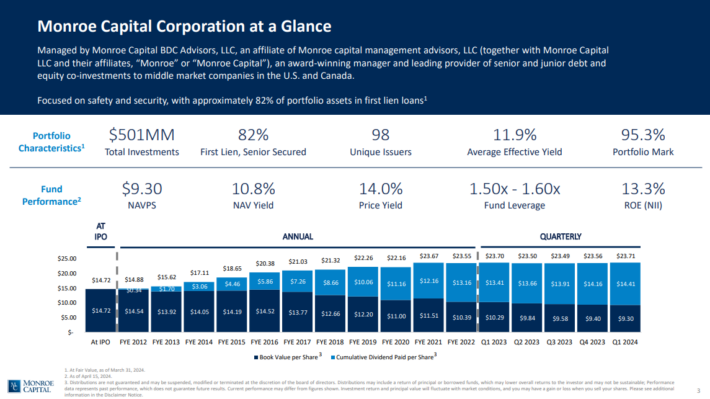

Source: Investor Presentation
On August 7th, 2024, Monroe Capital Corporation reported its Q2 results for the period ending June 31st, 2024. Total investment income for the quarter came in at $15.6 million, compared to $15.2 million in the previous quarter. The weighted average portfolio yield remained stable during the quarter, standing at 11.9%.
Nevertheless, a lower number of portfolio companies, which fell from 98 to 94, negatively impacted total investment income.
Click here to download our most recent Sure Analysis report on MRCC (preview of page 1 of 3 shown below):


BDC #4: Great Elm Capital Corp. (GECC)
- 5-year expected annual return: 11.7%
Great Elm Capital Corporation is a business development company that specializes in loan and mezzanine, middle market investments.
It seeks to create long-term shareholder value by building its business across three verticals: Operating Companies, Investment Management, and Real Estate.
The company favors investing in media, healthcare, telecommunication services, communications equipment, commercial services and supplies.
For the second quarter of 2024, GECC reported net investment income (NII) of $3.1 million, or $0.32 per share, compared to $3.2 million, or $0.37 per share, for the first quarter of 2024.
Net assets were $126.0 million, or $1.06 per share, down from $118.8 million, or $12.57 per share, at the end of March 2024.
The decline in net assets was partly due to additional write-downs on illiquid investments. The company’s asset coverage ratio stood at 171.0% as of June 30, 2024.
Click here to download our most recent Sure Analysis report on GECC (preview of page 1 of 3 shown below):


BDC #3: Goldman Sachs BDC (GSBD)
- 5-year expected annual return: 13.1%
Goldman Sachs BDC is a closed-end management investment company. GSBD provides specialty finance lending to U.S.-based middle-market companies, which generate EBITDA in the range of $5-$200 million annually, primarily through “unitranche” first-lien loans.
The company will usually make investments that have a maturity between three and ten years and in size between $10 million and $75 million.
As of March 31st, 2024, GSBD’s portfolio included 149 companies at a fair value of around $3.95 billion.
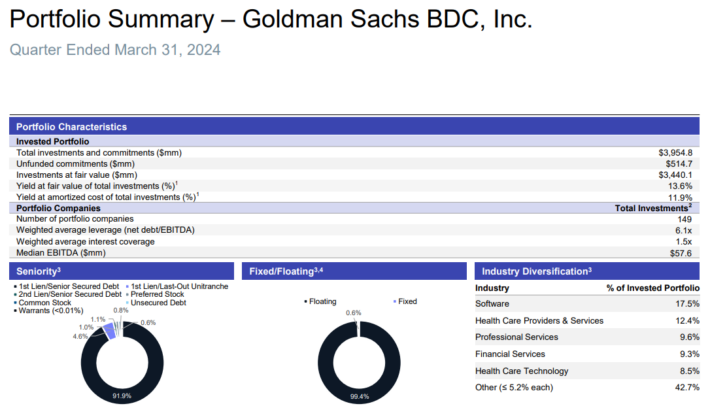

Source: Investor Presentation
The investment portfolio was comprised of 97.5% senior secured debt, including 96.5% in first-lien investments.
In the 2024 first quarter, total investment income of $115.5 million compared to $115.4 million in the previous quarter.
The decrease in total investment income was primarily driven by a decrease in accelerated accretion of upfront loan origination fees and unamortized discounts.
Click here to download our most recent Sure Analysis report on GSBD (preview of page 1 of 3 shown below):
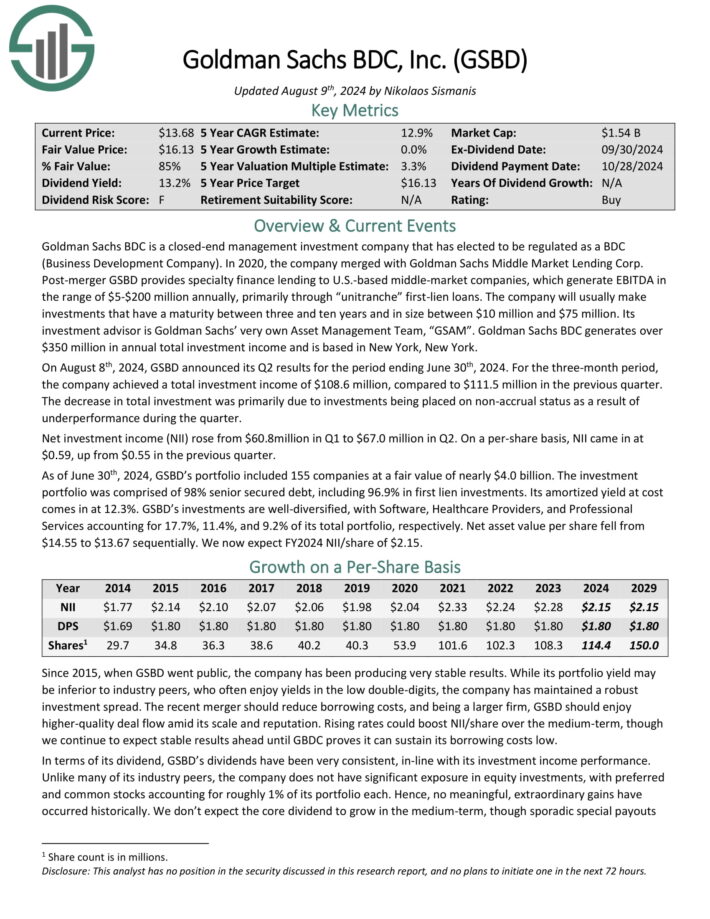

BDC #2: TriplePoint Venture Growth BDC (TPVG)
- 5-year expected annual return: 16.9%
TriplePoint Venture Growth BDC Corp specializes in providing capital and guiding companies during their private growth stage, before they eventually IPO to the public markets.
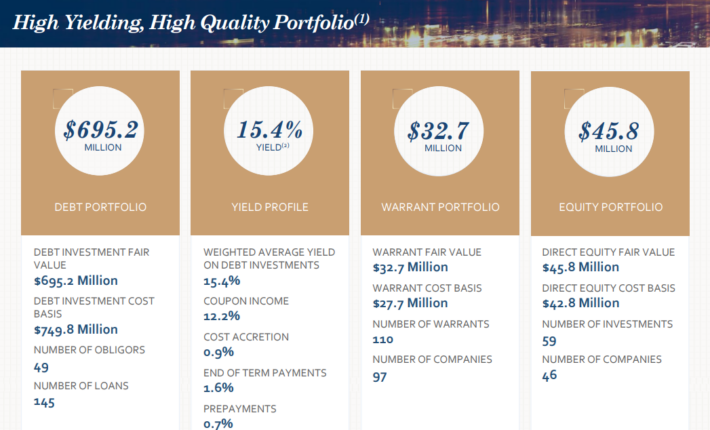

Source: Investor Presentation
On August 7th, 2024, TriplePoint Venture Growth BDC slashed its dividend by 25% to $0.30. On the same day, the company posted its Q2 results for the period ending June 30th, 2024.
For the quarter, total investment income of $27.1 million compared to $35.2 million in Q2-2023. The decrease in total investment was mainly due to a lower weighted average principal amount outstanding on the BDC’s income-bearing debt investment portfolio.
Specifically, the number of portfolio companies fell from 49 last year to 44. Nonetheless, the company’s weighted average annualized portfolio yield came in at an impressive 15.8% for the quarter, up from 14.7% in the prior-year period.
Click here to download our most recent Sure Analysis report on TPVG (preview of page 1 of 3 shown below):


BDC #1: Oaktree Specialty Lending Corp. (OCSL)
- 5-year expected annual return: 24.6%
Oaktree Specialty Lending provides lending services and invests in small and mid-sized companies. Its investments generally range in size from $10 million to $100 million and are principally in the form of the first lien, second lien, or collectively, senior secured, and subordinated debt investments.
As of March 31st, 2024, the investment portfolio accounted for $3.0 billion at fair value diversified across 151 portfolio companies.


Source: Investor Presentation
On August 1st, 2024, Oaktree Specialty Lending Corp. released its third quarter of fiscal 2024 results for the period ending June 30th, 2024. For the quarter, the company reported adjusted net investment income (NII) of $45.2 million or $0.55 per share, as compared with $44.7 million, or $0.56 per share, in the second quarter of fiscal 2024.
The increase in earnings was primarily driven by lower Part I incentive fees, partially offset by a decrease in adjusted total investment income.
Click here to download our most recent Sure Analysis report on OCSL (preview of page 1 of 3 shown below):
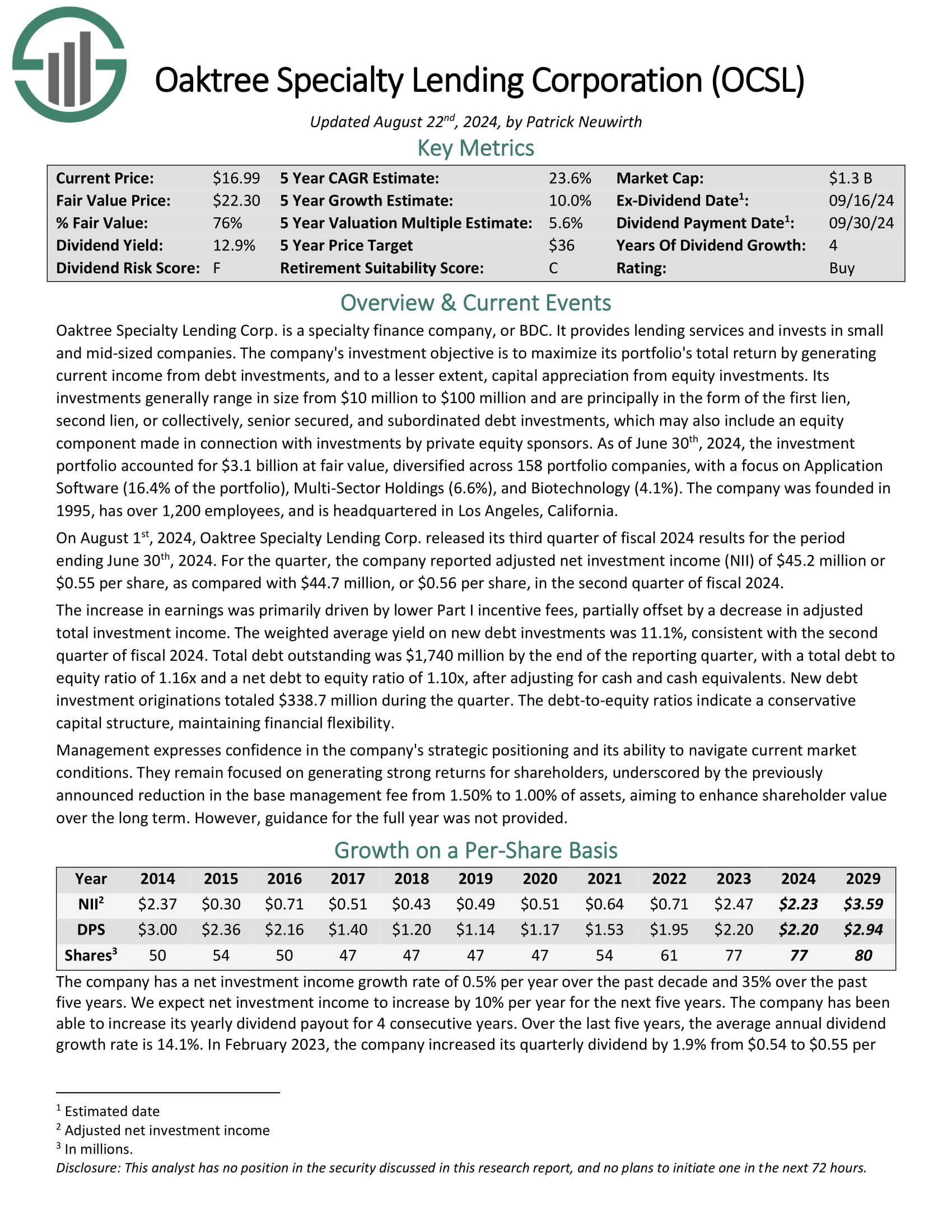

Final Thoughts
Business Development Companies allow everyday retail investors the opportunity to invest indirectly in small and mid-size businesses. Previously, investment in early-stage or developing companies was restricted to accredited investors, through venture capital.
And, BDCs have obvious appeal for income investors. BDCs widely have high dividend yields above 5%, and many BDCs pay dividends every month instead of the more typical quarterly payment schedule.
Of course, investors should consider all of the unique characteristics, including but not limited to the tax implications of BDCs. Investors should also be aware of the risk factors associated with investing in BDCs, such as the use of leverage, interest rate risk, and default risk.
If investors understand the various implications and make the decision to invest in BDCs, the 5 individual stocks on this list could provide attractive total returns and dividends over the next several years.
At Sure Dividend, we often advocate for investing in companies with a high probability of increasing their dividends each and every year.
If that strategy appeals to you, it may be useful to browse through the following databases of dividend growth stocks:
- The Dividend Aristocrats List: S&P 500 stocks with 25+ years of dividend increases.
- The Dividend Kings List is even more exclusive than the Dividend Aristocrats. It is comprised of 53 stocks with 50+ years of consecutive dividend increases.
- The High Dividend Stocks List: stocks that appeal to investors interested in the highest yields of 5% or more.
- The Monthly Dividend Stocks List: stocks that pay dividends every month, for 12 dividend payments per year.
- The Dividend Champions List: stocks that have increased their dividends for 25+ consecutive years.
Note: Not all Dividend Champions are Dividend Aristocrats because Dividend Aristocrats have additional requirements like being in the S&P 500.
Thanks for reading this article. Please send any feedback, corrections, or questions to support@suredividend.com.

